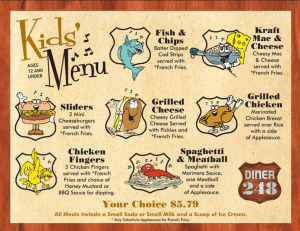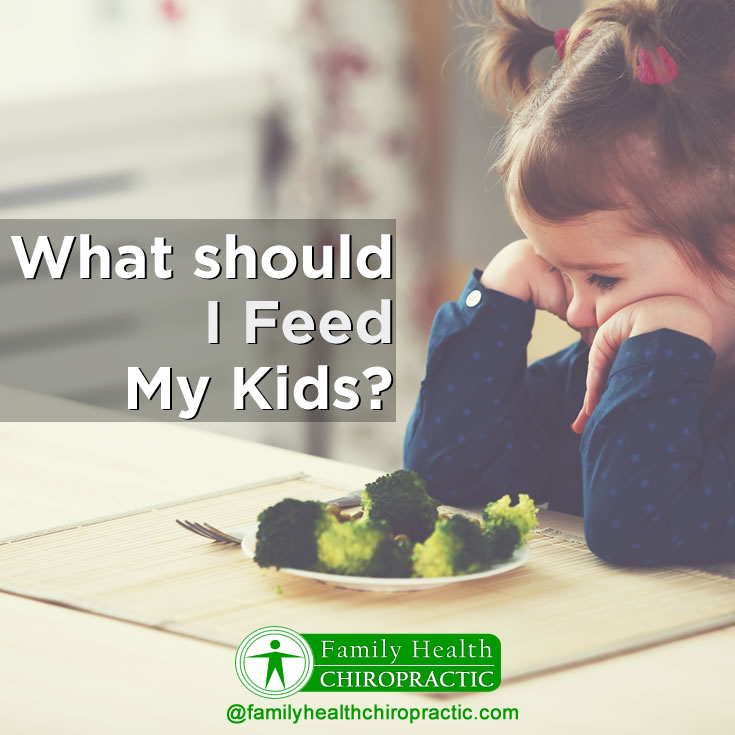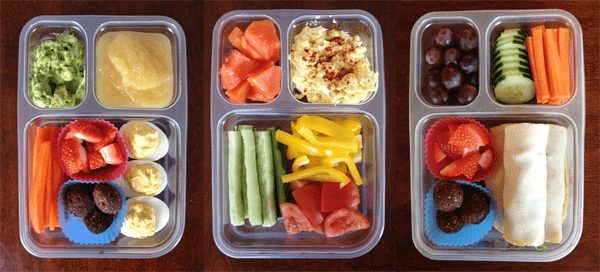The question is an important one: What should I feed my kids?
Is milk good for them?
Can they eat bread and pasta? Or should I put them on a gluten free diet?
What about vegetables? They won’t eat vegetables!!!
With so many parents asking me questions like this weekly, it just confirms how bad things have gotten when it comes to human nutrition. We are a completely confused and out of touch species. No other animal on the face of the planet spends so much time thinking about what or how they should eat.
In this article I am going to discuss nutrients kids need the most, and how to monitor their personal nutrition for optimal health.
Let’s start with The Standard American Diet
Don’t you think it’s just a little ridiculous that we separate menus between adults and children; as if they have different nutritional needs than us? For example, if you go to a restaurant with a child, one of the first things they’re going to ask is “How many kid menus would you like?”

What about grocery store options for our children? Take a walk down any breakfast cereal grocery store lane and you’re sure to find evidence of “Big Food” industry marketing at its best. These so called “food companies” literally market us to death, with names like Trix for Kids, Cap’n Crunch, Fruit Loops and quite honestly, I don’t even know any more other than that.
What I do know is that these sugar-crisp, puff-balls of crap are all totally processed and refined food products, that absolutely do nothing for starting the day off right. They are literally so far away from food and nutrition, that we might as well give little Timmy a cigarette to smoke right after.
Then there’s a whole range of packaged lunch products such as lunchables, juice boxes, stuff that’s squeezed out of plastic tubes and a whole other mess of frozen food products that we can send them to school with. Let’s not even discuss food dished up by schools!
The reality here is that the food we feed our children is not food. It’s pretty typical now for families to prepare an entirely different meal for their kids, whether its breakfast, lunch, or dinner, then what the adults in that same family are eating.
This is a serious problem.
It’s also a symptom of a food culture we’ve developed in this country based on the idea that our kids are somehow different than us when it comes to human nutrition. It’s a culture where you yourself would not eat that donut or bag of chips, but you’d happily hand it over to your child? Because it's just 1 small bag, right?
What if you didn’t have the idea of “Kids Food”? What if there were no “Kids Menus”?
Then you’d be left with feeding your kids the same kind of foods you eat. You’d end up spending way less money on “food products” and your children would eventually learn to eat “Real Food”.
Anytime someone asks me a health question, my gut instinct is to travel back in time, approximately 30,000 years ago and I ask how that question applies then.
What kind of diet is good for my child?
Evolutionarily speaking, there’s no such thing as kids’ food (beyond breast milk). There was just food in hunter-gatherer cultures or there wasn't. And when there was food, that is what we ate. It’s what everyone ate.
What’s funny is that you don’t even have to go back 30,000 years. Just go back 100 years and ask the same question. I’m confident that you’d find that kids were eating the same foods as their parents.
If you’re having grilled chicken, sweet potatoes and roasted cauliflower for dinner- that’s what your kids should eat. If you're having salmon, asparagus and rice- that's what the kids should eat. And if you go out to eat, the only sensible reason to ask for a kids menu is to play tic-tac-toe or color on it. Let your children order off the adult menu and get their taste buds acclimated to real food.
“But my kids won’t eat that.” Too bad.
Really!?! Why is it ok for an adult to have self-preservation and control over the food they eat and not pass that on to our children?
It’s not that your child won’t eat the food. It’s that their taste buds are so over stimulated by artificial food products, salt, fat and sugar that “real food” is not appealing to them.
But the good news is that it can change. They just need some help and discipline to do it. We all do.
That’s step 1 of How kids should eat.
What Nutrients Do Kids Need the Most?
The answer to this question is not much different from what you’d need. The real difference is that it’s actually more important that they get adequate amounts of nutrients because they’re still developing. There’s a small window of opportunity, where children's brains and bodies are developing and if we miss out on that, then we’re setting them up for failure.
So the stakes are actually much higher for ensuring that your children eat “nutrients” rather than “food products”. I believe that we all should start with a basic Paleo type of diet. A Paleo or ancestral diet is the foundation of how to eat; and then from there we begin to customize to fit our individual needs. The same is true with your children.
Here are a few nutrients that you should focus on:
Fats and Fat Soluble Vitamins
Arguably, the most important nutrient for a child is fat. Breast milk is primarily fat, including saturated fat. So the next time someone says saturated fat is bad for you; ask them to debate that argument with a few million years of evolution first. Certainly the name — fat — may make it sound like something you shouldn't eat. But fat is an important part of a healthy diet. And little kids, especially, need a certain amount of fat in their diets so the brain and nervous system develop correctly. That's why its recommended that toddlers need to drink whole milk.
Other foods that are high in fat and fat soluble vitamins include organ meats, cold-water fatty fish and pasture-raised eggs. Speaking of pasture-raised eggs, choline and glycine are two nutrients found in egg yolks that play a major role in normal brain development, nerve function, muscle movement and energy levels.
EPA and DHA are also crucial for brain development. Foods that contain EPA and DHA include cold-water fatty fish, shellfish and pasture raised eggs, nuts and seeds.
Phytonutrients and Minerals
Crucial but often forgotten minerals include Zinc, Iron and Copper. Zinc, iron, and copper offer a wide range of benefits, and organ meats and shellfish are by far the most nutrient-dense sources for those nutrients. It’s also important to know that with all three of those minerals, the absorption of those nutrients from plant foods is much lower than the absorption from animal foods. It doesn’t mean the plant foods that contain them don’t have a lot of other benefits and that you might not get some of those nutrients from the plant foods, but you’re not going to absorb nearly as much as you would from shellfish, organ meats, muscle meats, or other animal products.
But that also leads to the discussion of phytonutrients. Phytonutrients are nutrients found in plants that develop to protect the plant from damaging environments. Plants are exposed to excess ultraviolet radiation, predator pests, toxins and pollution, resulting in the generation of dangerous free radicals within their cells. These free radicals can then bind and damage proteins, cell membranes and DNA of the plant.
Fortunately, phytonutrients simultaneously develop to shield the plant from such damage as well as provide their color, flavor and smell. As you can imagine, eating these phytonutrients also provides us with protection.
Each plant that you eat contains tens of thousands of different phytonutrients that can act as antioxidants, hence it’s key to eat high-antioxidant foods in order to fight free radical damage. Phytonutrients that are present in fresh fruits and vegetables are very important, and the fiber that’s present in those foods is really crucial to feeding their beneficial gut bacteria, which we know is one of the most important things that we need to focus on for ourselves and our children.
University of California Berkeley journalism professor and author, Michael Pollan, goes further to say that in addition to getting the phytonutrients from whole fruits, vegetables and herbs, we need to consider the source. He shares concerns about the overuse of genetically modified foods like corn in everything from the animals we consume as meat to the production of highly processed foods, which includes most things you find in the supermarket. So it’s certainly best to shop at farmers’ markets and to look for non-gmo labeling!
Last but not least, children need protein!
Making sure that kids are getting enough protein for the development of their muscles, tissues, and enzyme activity is crucial. Think of protein as the scaffolding of the body. It’s what is necessary to build the support structures that make us strong and durable. Protein builds, maintains, and replaces the tissues in your body. Your muscles, your organs, and your immune system are made up mostly of protein.
How to Monitor Your Child’s Nutrition
If your child’s diet is very rich in all of these various micronutrients and macronutrients, then I wouldn't worry.
However, if you are concerned about their nutritional status, you might consider having some testing done to make sure that they are in the right ranges. There are several urine organic acids testing through labs like Genova Diagnostics, who provide the ION Profile or NutrEval tests, which can be helpful in identifying deficiencies of certain nutrients.
Above all, make sure your kiddos are getting enough to eat overall and that their calorie intake is sufficient for their activity. Usually kids are pretty good when it comes to eating according to their hunger. If they’re hungry, they’ll let you know about it and you feed them and it’s relatively that simple.
But in many cases, kids will eat out of habit. Often they will want to “snack” rather than eat for sustenance. So I’d like to add that you need to make sure that you’re not letting them attack the pantry in a nonsensical way.
Also, if they have any issues, like SIBO or gut problems, undiagnosed parasites, or constipation, those could potentially affect appetite, and perhaps the kids are not eating as much as they normally would otherwise.
Depending on what their overall intake of carbohydrate is, sometimes what we’ve seen with adults is that when people go on, unintentionally, a kind of low-carb Paleo type of diet, their overall calorie intake drops as well. If they’re really active they may not be getting enough carbohydrates to fuel their particular activity levels.
I think the idea that kids have to eat grains and dairy to be healthy is ridiculous because for the vast majority of human history, kids and adults were not eating grains and dairy. That was the natural human diet. It didn’t include those foods. But, there is something to be said for getting enough food and calories overall, and so things like sweet potatoes, plantains, yuca, taro, these starchy tubers can be really important for kids to make sure they’re getting enough calories and enough glucose to fuel activity levels, especially if you’re not including grains, dairy products, and things like that.
Last thing I’d like to discuss is white rice. As many of you know, I think that white rice, which is just starch, can be a fine addition to the diet as long as it doesn’t replace more nutrient-dense foods and as long as it’s well tolerated. So if you absolutely know that your child is not having any sort of reaction to white rice, it can be a way of increasing calorie intake as well, particularly carbohydrate.





